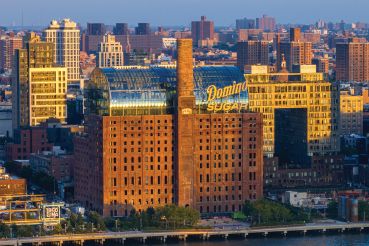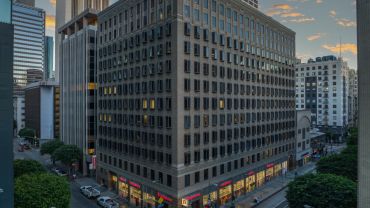
On its front page last Friday, Jan. 8, The New York Times chose to paint a gloomy view of Manhattan office leasing for the upcoming year. Good for selling newspapers, perhaps, but misleading in context. Manhattan has made it through worse times, and the borough’s historical resiliency proves it will weather the current slump.
The article mentioned that 180 major buildings are in trouble and that rents fell faster for commercial office space in the past two years than in any other time in the past 50 years. It went on to cite predictions by economic and research professionals that office building value will decline 58 percent this year from the 2007 peak, and that it will take until 2014 for a major turnaround.
Some of us with long memories have watched Manhattan show its strength for 40 years, and that proof is in the numbers.
In the early 1970s, when the stock market collapsed and the U.S. experienced one of the gravest oil crises in its history, Manhattan did not emerge unscathed. Rents throughout Manhattan had reached a level above $13 per square foot on average ($72 per square foot in today’s dollars) at the peak of the market in the early 1970s, and then lost close to half of their value by 1975, hitting the bottom at just under $8.75 per square foot (about $35 per square foot in today’s dollars). As a result of this downturn, New York had, in fact, gone bankrupt. The drop in office rental rates of the mid-1970s was much more severe than the 33 percent reduction we have experienced in this downturn thus far.
It took the Manhattan office-space market roughly five years to climb back to its peak from the levels last seen in the early 1970s. The large oversupply of newly constructed office space that had entered the Manhattan marketplace between 1970 and 1973 contributed significantly to the slow office-rent recovery. The two World Trade Center towers and buildings such as 1211, 1221 and 1251 Avenue of the Americas added more than 15,000,000 square feet to the marketplace.
However, despite the economic crisis of the 1970s, by 1977, leasing transactions were already being completed at levels significantly above the market average. Citicorp Center (now named 601 Lexington Avenue), then under construction, was considered a new, exciting office development, and rental rates of $18 per square foot (equivalent to $64 per square foot in today’s dollars) were achieved; the average in other buildings came close to $10.50. Major tenants such as Ernst & Young made substantial commitments (125,000 square feet) to relocate to this building.
The late 1980s presented another challenge to the Manhattan office-space market, as well as an opportunity for Manhattan to prove its resiliency. In the years following October 1987’s Black Monday and following the first Gulf War, Manhattan rentals dropped nearly 28 percent in value. By September of 1992, unemployment in New York City had soared from 5.4 percent to 11.7 percent. As with the construction boom of the early 1970s, some of Manhattan’s most notable office buildings were completed at this time, such as Zeckendorf’s Worldwide Plaza in 1989, which secured Cravath Swaine & Moore LLP as its anchor tenant. This building was almost completely leased by the time rentals hit the bottom in this particular cycle. The office-space market did not recuperate from the early 1990s until approximately 1995. By this time, the national economy was growing at a steady pace; unemployment levels had decreased; and the stock market was rising.
From 2000 to 2004, the bursting of the dot-com bubble and the events of Sept. 11, 2001, forced another decline in the Manhattan office marketplace. Within a span of three years (2000 to 2003), office rental rates lost 28 percent of their value, and vacancy rates spiked from 2.6 percent to a high of 9.7 percent in midtown. However, by the second half of 2003, rental rates were rising with velocity. Compared to the other downturns, the crisis of the early 2000s was the mildest and the shortest-lived. Employment in Manhattan did not suffer to the extent it did in the prior crises. Unemployment went from 5.2 percent in the beginning of 2001 to 8.6 percent in February 2003, but went back down to 5.5 percent by the end of the first quarter of 2005. The 52.5 million square feet of office space that was put on the market during the downturn was nearly fully absorbed by the end of 2004.
Today’s circumstances are no more dire than those of the past. Rents have lost a third of their value since the 2007 market peak; vacancy rates have risen from 5.5 percent to a high of more than 10 percent in certain submarkets; and unemployment rates are high. However, certain conditions that prevailed in past downturns and mitigated against Manhattan have diminished, or are gone altogether. Others developed that should strengthen leasing. Working now on Manhattan’s behalf are these new realities:
1. In the past, tenants left Manhattan for a wide range of factors, not the least of which was crime and quality of life. Today, New York is America’s safest big city, and most tenants connected with the financial industry, international businesses, or law firms above a certain size believe a Manhattan presence is a must. The perception of Manhattan as a vital business center is stronger than ever.
2. International business centers like London and Tokyo have far higher operational costs.
3. Global currency fluctuations make Manhattan more economical for first offices or expansions.
4. Manhattan leases approximating 20,000,000 square feet expire in 2010. Tenants must renew or relocate.
5. There is no over-construction, as there was in most past cycles.
6. Health care, education and media are now critical growth industries, lessening the city’s heavy dependence on the financial and related industries.
This coming year may not be one for the record books, but there are four decades of reasons to believe that 2010 will be one where we see positive leasing activity, and that alone is good news.
Rick Marek is the chair of the REBNY Plaza Committee and a director of the Commercial Brokerage Division. Marina Donova and Jordan Mandel assisted in this op-ed.


